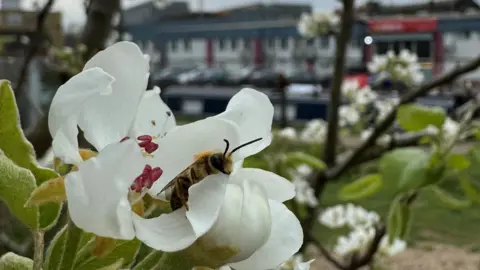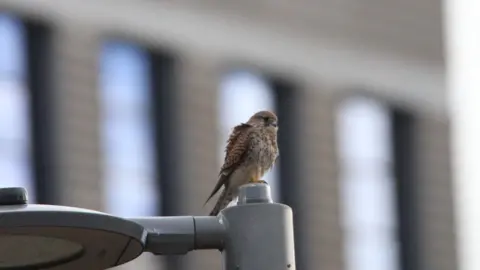Olympic Park 'bio-blitz' finds thriving wildlife
 Tom Bellamy
Tom BellamyA variety of flora and fauna are thriving in east London's Queen Elizabeth Olympic Park, where more species of bee, bird, wasp and lichen have been found.
Before the 2012 Olympic Games, the Stratford site was mostly industrial wasteland with contaminated soil, polluted waterways and extensive fly-tipped waste.
The latest discoveries were made in a recent "bio-blitz", an intensive biological survey with experts from the London Natural History Society, UCL and Hackney Council.
Ecologist Tom Bellamy said: "I have been really surprised at the biodiversity that's been achieved here in such a short time – especially considering how polluted a lot of the ground here was before the London 2012 Games."
 Tom Bellamy
Tom BellamyThe survey identified three species of bee now in the park: the coastal leafcutter, sickle-jawed blood bee and the large sharp-tailed bee. It also recorded a species of hyper-parasitic wasp and a species of cuckoo wasp, 23 species of butterfly, 42 bird species, as well as 23 species of lichen.
Otters, eels, kestrels, house martins, sand martins, the nationally scarce black mining bee and large scabious mining bee, and the soft-winged flower beetle - a threatened species across Europe - were all found in East Village, the site of the Athletes' Village during the 2012 Games.
 Tom Bellamy
Tom BellamyQueen Elizabeth Olympic Park ecologist Mr Bellamy said: "We have kingfishers, otters, eels and it's incredible that nationally scarce species of bees have been found here.
"Part of my job is to establish breeding populations for a wide variety of select species that we want to breed on the park.
"I'm proud of what's been achieved so far but there is always more we can do."
Listen to the best of BBC Radio London on Sounds and follow BBC London on Facebook, X and Instagram. Send your story ideas to [email protected]
